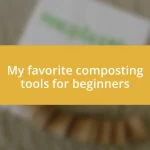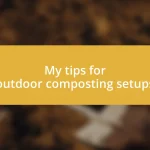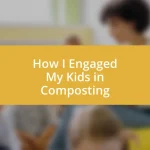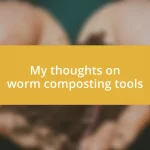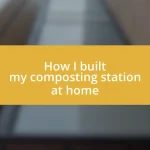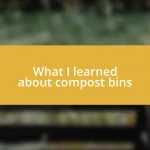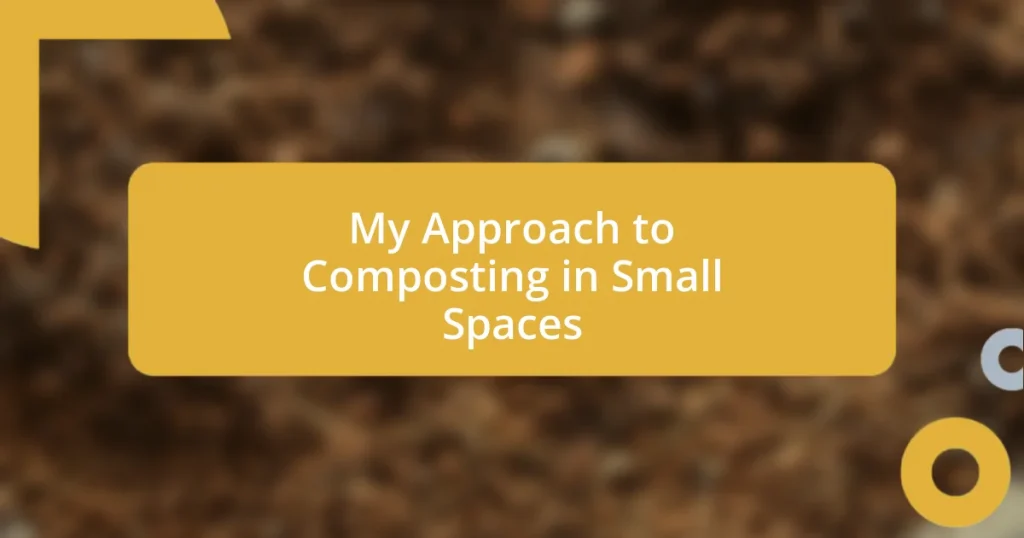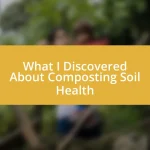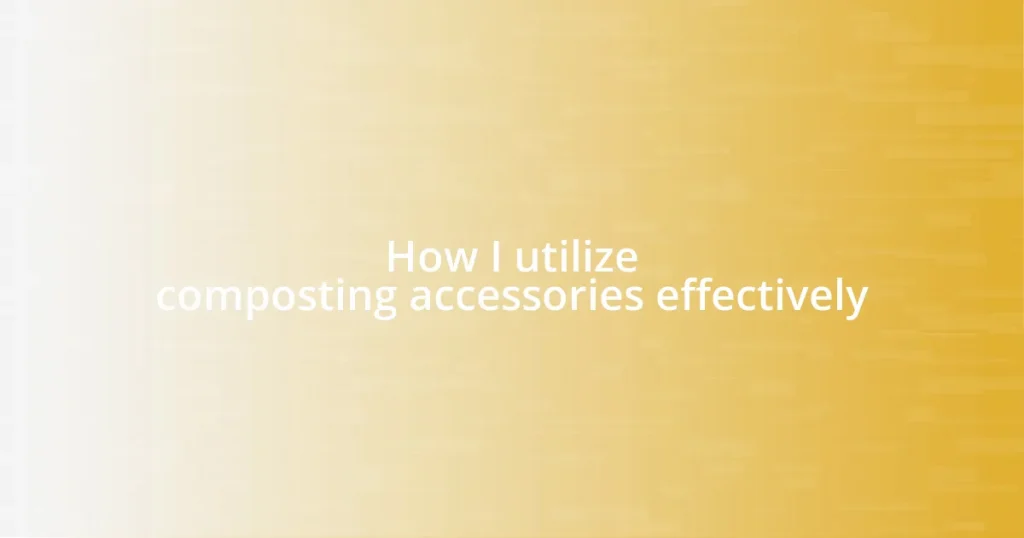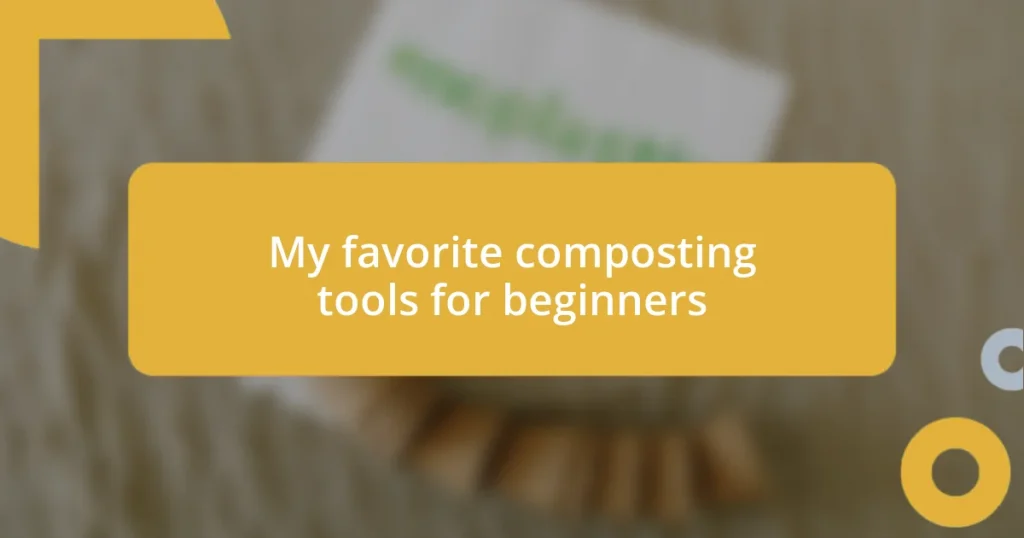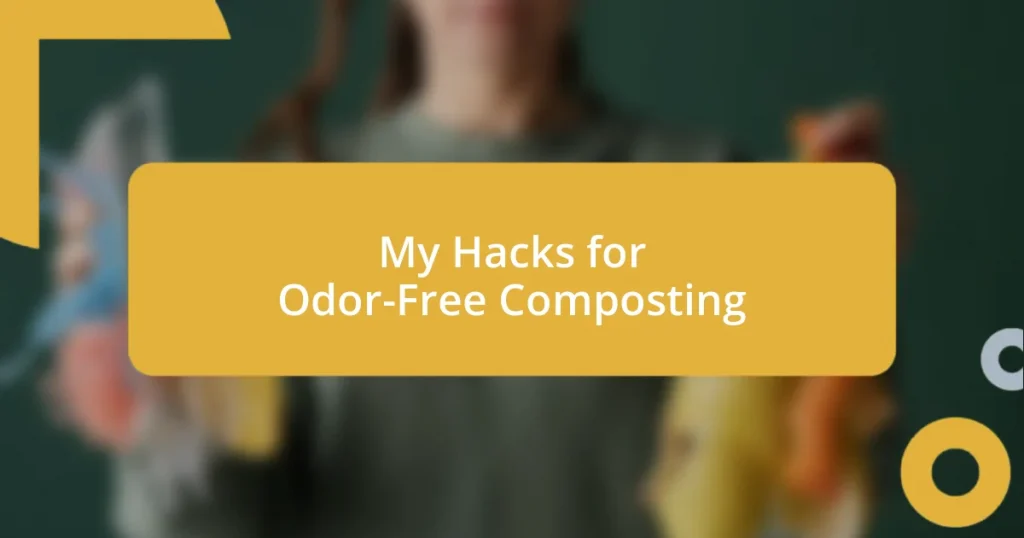Key takeaways:
- Composting requires a balanced mix of nitrogen-rich greens and carbon-rich browns for effective decomposition.
- Choosing the right composting method and container is crucial, especially in small spaces, to avoid issues like odors and pests.
- Regular management, such as turning the compost and monitoring moisture and temperature, is essential for achieving optimal results.

Understanding composting basics
Composting might seem overwhelming at first, but at its core, it’s simply nature’s way of recycling organic matter. I remember my initial attempt at composting – I was filled with excitement but also a bit of anxiety about whether I was getting it right. Isn’t it fascinating how something as straightforward as combining kitchen scraps and yard waste can transform into rich, fertile soil?
To compost effectively, you need a balance of greens and browns. Greens are nitrogen-rich materials like fruit scraps, while browns include carbon-rich elements such as dry leaves. When I first learned about this balance, it was a lightbulb moment. Have you ever tried to create the perfect recipe in the kitchen? Composting is similar; the right mix leads to incredible results.
Aeration is another vital component of composting. Turning your pile or using a compost tumbler allows oxygen to circulate, speeding up the decomposition process. I often found myself eagerly checking my compost bin, marveling at the remarkable transformation happening inside. It’s almost like watching a magic trick unfold! So, are you ready to dive into the rewarding world of composting?

Choosing the right composting method
Choosing the right composting method can be a game changer, especially in small spaces. When I first moved into a tiny apartment, I didn’t think I had the room for composting. However, once I explored my options, I realized there are several effective methods tailored for limited areas—each with its own unique benefits.
Here are a few methods that worked well for me:
-
Vermicomposting: Using worms to break down food scraps not only saves space but also produces nutrient-rich liquid fertilizer. I was pleasantly surprised by how little odor there was!
-
Bokashi: This fermentation-based method is excellent for small kitchens. It allows you to compost without the need for oxygen, making it a perfect fit for those with limited room. I loved how quick it was to set up and use.
-
Compost Tumblers: These are great if you have a little outdoor space. They keep pests at bay and speed up the composting process. Rolling it around felt a bit like a workout, but it was so satisfying to see my efforts pay off quickly.
Finding the right method made all the difference for me. Each approach gave me a sense of accomplishment and a connection to the sustainability journey, which felt incredibly rewarding.

Essentials for small space composting
The essentials for small space composting revolve around choosing the right tools and methods suited for your environment. The first item on my checklist would be a good compost bin. When I selected my bin, I opted for a compact design with sufficient aeration holes. This decision not only helped keep odors at bay but also made turning the compost a breeze. Have you considered how the right bin can transform your composting experience? It feels like finding the perfect fit for a beloved pair of shoes – it just works!
In addition to a quality bin, maintaining a balance of materials is crucial. For a small composting setup, I learned to keep a handy supply of both greens—like vegetable scraps—and browns—such as shredded paper or dried leaves. One memorable afternoon, I decided to use leftover coffee grounds, and it worked wonders! Watching the mix decompose into rich, dark soil is a gratifying visual reminder that even small contributions can lead to significant results. How do you keep your materials organized, and what small space hacks have you found helpful?
Lastly, I cannot stress enough the significance of monitoring moisture levels. A compost pile that’s too dry can stall the process, while one that’s overly wet can lead to foul odors. I remember my initial excitement led me to neglect this aspect, and my compost turned a bit soggy. Afterward, I learned to always check my pile’s consistency and added dry materials when needed. It was a small change, but it made a world of difference in fostering a thriving compost ecosystem.
| Essential Tools | My Experience |
|---|---|
| Compost Bin | A compact design with proper aeration holes prevents odors and allows for easy turning. |
| Material Balance | Keeping both greens and browns handy leads to faster decomposition and richer soil. |
| Moisture Control | Regularly checking moisture levels ensures a thriving compost pile without foul odors. |

Selecting suitable composting containers
Selecting the right composting container can truly influence your composting journey, especially in tight living quarters. During my first attempt at composting, I picked a small, stackable bin. Characterized by its compact design and breathable materials, it quickly became my favorite. I was amazed by how diligently it worked, transforming kitchen scraps into nutrient-dense compost without occupying much space at all.
In my experience, it’s also essential to consider what kind of lid your composting container has. I once used an open-top bin because I thought it would be more ventilated. I quickly learned that pests can be a crafty little disruption. Switching to a container with a secure, locking lid not only kept rodents at bay but also retained moisture, ensuring my compost was always in the right state. Have you ever faced a similar dilemma? Discovering that solution felt like cracking a secret code to successful composting!
Lastly, the material of your bin can’t be ignored. I went for a sturdy plastic since it seemed manageable in weight and easy to clean; however, I did wish I had considered options like metal or wood, as they’re often more durable. Reflecting on it, I realized that the longevity of a compost bin can really pay off in the long run. So, when choosing yours, I recommend pondering over how committed you are. The right choice now can save you time and money later—what do you think would work best for your space?

Managing compost for optimal results
When it comes to managing compost for optimal results, I’ve learned that regular turning is key. I recall my first compost pile turning into a gooey mess because I neglected this step. Once I started flipping it weekly, magic happened! The structure improved, and the breakdown sped up. Do you regularly give your compost the attention it needs?
Temperature is another crucial factor. A few times, I didn’t monitor the heat in my compost pile, thinking it would take care of itself. To my surprise, the microbial activity stalled, slowing decomposition down. Now, I place my hand near the pile—if it feels warm, I know I’m on the right track. Have you ever felt that satisfying warmth radiating from a well-managed compost?
Finally, I can’t underestimate the value of patience. Composting is not a race, and I’ve had moments where I wanted instant results. I learned that nurturing my pile and allowing nature to do its thing was the best approach. Watching the transformation from kitchen scraps to rich soil over weeks taught me a lesson in trust—can you recall a time when waiting led to rewarding results in your own gardening experiences?

Troubleshooting common composting issues
When troubleshooting common composting issues, one of the first challenges you might encounter is an unpleasant odor from your compost bin. I remember the first time I opened my container and was hit with a surprisingly foul smell—yikes! After some research, I discovered that adding more browns, like dried leaves or shredded paper, helped balance the nitrogen-rich greens, significantly reducing the odor. If you ever find yourself in a similar stinky situation, think about adjusting that balance to bring back the fresh earthy scent.
Another issue that can arise is the presence of unwanted critters. I once found my compost bin twinkling with flies, and it was frustrating! To combat this, I started burying kitchen scraps under a layer of browns instead of simply tossing them on top. This not only helps deter pests but also provides them with some covering, making the whole composting process a lot more efficient. Have you dealt with a pest invasion in your compost, and how did you handle it?
Finally, if your compost isn’t breaking down as quickly as you’d hoped, it might be too compacted. I distinctly remember my disappointment when, despite my efforts, things just weren’t composting right. I learned to incorporate more air by mixing in larger pieces and turning the pile more frequently. Now, with each gentle aeration, I see the decomposition process speed up, which always gives me a sense of accomplishment. So, when you approach your compost, ask yourself: is it truly having enough breathing space?

